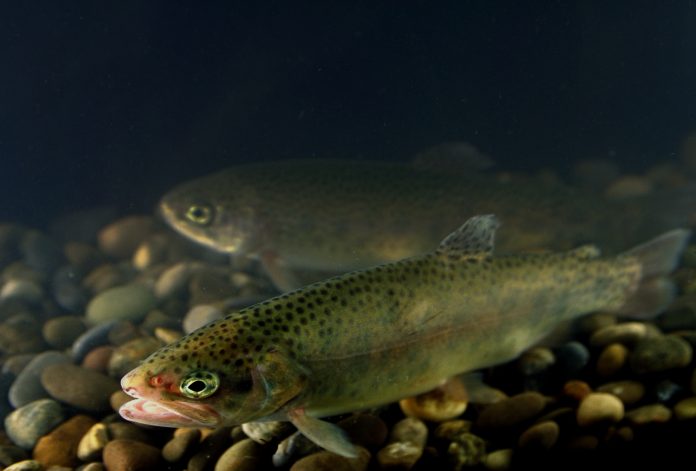Central State University researchers are aiming to create more opportunities in hemp and aquaculture, with a recently funded project.
An Agriculture and Food Research Initiative grant from the U.S. Department of Agriculture, National Institute of Food and Agriculture will support the project, which seeks to get hemp grain approved as a feed ingredient for fish feed, expand markets for hemp and trout and increase diversity in agriculture. Partners on the project include two 1890 land grants and one 1994 land grant.
“I have been thinking about this project since the day I arrived at Central State University, in 2019,” said Brandy Phipps, research assistant professor in food, nutrition and health, and a lead for the project.
Project
Phipps has a background in biomedical sciences with a focus on nutrition. Much of her work has connected with food access and equity, and addressing systemic issues for public health.
She will focus on education, extension and community outreach, while Craig Schluttenhofer, assistant professor of natural products at Central State, will be overseeing much of the research on hemp, aquaculture and economics.
They are partnering with Wisconsin’s College of Menominee Nation, Kentucky State University, University of Kentucky, Mississippi State University and University of Delaware.
Fish
One of the main research goals is to do studies that will allow the U.S. Food and Drug Administration and the Association of American Feed Control Officials to decide whether hemp grain is a suitable feed for fish or not.
One of the concerns is whether THC or other compounds in hemp can accumulate in organs or tissue of animals. Even though hemp for grain has much lower levels of those than hemp grown for CBD, it still has trace amounts, Schluttenhofer said. He plans to study that extensively so the agencies will have the information they need to make a decision.
Fish can be a nutrient-dense, healthy food. But some fish get fish meal or fish oil to supplement their diets. That’s a major cost for aquaculture producers. It’s also not great environmentally.
The researchers believe hemp ingredients could replace some or all of the fish meal and fish oil in fish feed. If that proves to be true, aquaculture producers could raise fish at a lower cost and with less negative environmental impact. That could open up opportunities for more people to get involved in fish farming.
“I would like to see more small producers of aquaculture, especially in underserved communities,” Phipps said.
Hemp
Schluttenhofer is also interested in the project because of how it could open up markets for hemp.
“The vast majority of stuff being grown in the U.S. is for the metabolites,” Schluttenhofer said. But there’s a limited amount of demand for those, and now, he thinks, there is plenty of hemp being grown to fill that part of the market.
“Grain and fiber, I think, show long-term potential,” he said. “I’m very interested in the grain side.”
If hemp grain is a viable ingredient for fish feed — both from a health standpoint, and economically — that opens up opportunities for hemp grain markets.
“We know that there has been a lot of interest in the hemp sector to diversify the market,” Phipps said. “There hasn’t been as much production in the fiber and in the grain sector in this country.”
Partners
Through the partnership with the College of Menominee Nation, she hopes to help increase the number of Native Americans with degrees in agriculture, and offer training for Native Americans who want to grow hemp or raise fish. The project also plans to create more research opportunities at the college.
“There’s going to be lots of positive impacts from this work no matter what, despite whatever we find on the research side,” Schluttenhofer said.
The community around College of Menominee Nation is also a food desert, said Brian Kowalkowski, dean of continuing education at the college. Their extension program does a lot of work around food sovereignty and food access issues. The College of Menominee Nation’s goal is to offer more opportunities and resources for members in its community through the project.
The local high school has an aquaponics system, so getting involved in this project gives students an opportunity to learn more about aquaponics after graduating. The community also has high rates of health issues like diabetes and heart disease, so Kowalkowski is interested to see if the project can expand healthy food options for the community by making it more cost-effective to raise fish.
“I see this as a great opportunity to bring two minority-serving institutes together, having cross-cultural expertise that can help all of the partners involved,” Kowalkowski said.
The College of Menominee Nation is a 1994 tribal land grant college. Central State is an 1890 land grant, and while it may not have the same history of larger 1862 land grant universities, it has had more opportunities for longer than the 1994 land grants, Phipps said. That’s why, from the beginning, they knew they wanted to partner with a tribal college.
“We both [Schluttenhofer and Phipps] believe strongly in using whatever privilege and resources we may have access to, leveraging those to amplify the needs and help meet the needs of individuals who may not have access,” Phipps said.












